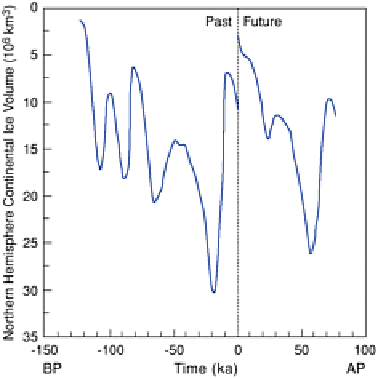Environmental Engineering Reference
In-Depth Information
Figure 9.16
Model simulation of continental ice volume for
the last 120,000 years and the next 80,000. The sudden
decrease in ice volume at present is due to the enhanced
greenhouse effect.
Source: After Goodess et al. (1992).
CONCLUSION
It is clear that in the medium to long term, over the time scale of tens to thousands of
years, our climate varies, not randomly but systematically. Broad, consistent fluctuations
occur, giving periods of relative warmth and periods of coldness, years of aridity and
years of wetness. The reasons for the fluctuations are not clear; variations in Earth's orbit
and rotation, changes in solar output, internal adjustments to the vegetation, topography
and atmosphere, all may be contributory factors. The time scale of possible causative
factors is shown in Figure 9.17, but we must not forget that most of the factors are
interactive; we cannot isolate a single process and describe its consequences with much
confidence. In recent centuries human activity has almost certainly begun to have an
impact on climate. Two questions remain. What is the effect of these climatic
fluctuations? And where is our climate going now?
Some of the effects are all too apparent to us. In those areas which are marginal to
agriculture, like parts of the Sahel, minor changes in climate may have appalling
consequences, bringing crop failure, soil erosion and famine.

